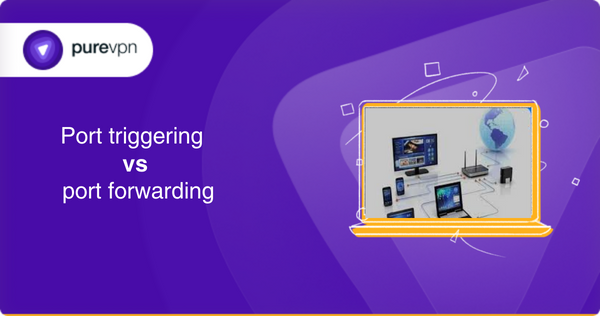Table of Contents
Port triggering and port forwarding are both pretty good techniques to allow incoming traffic on your local network from a specific device. While some people are confused about the concepts, both methods serve their purpose.
In this article, we will learn the difference between these two techniques. You will also get an idea of which technique will suit you.

What is port triggering?
Port triggering is a technique in which incoming traffic is available to access specific ports and devices on the local network for a certain time after establishing the outbound connection. The method allows the ports to be opened only when they are needed. This improves the security of the network and decreases the risk of hacking.
Setting up the ports for triggering involves configuring your router to monitor outgoing traffic on a specific port from a specific device. Whenever your router detects outbound traffic on a specific port it automatically opens ports.
For example, if you want to make a gaming console access to the internet, you would configure your router to monitor outgoing traffic on the specific gaming console port. When the gaming console connects to a server, the router will automatically open the port and allow incoming traffic to reach the gaming console.
This method can be less reliable than port forwarding since it requires an outbound connection to be made before the port can be opened.
What is port forwarding?
The technique in which specific ports allow incoming traffic from a specific device on a local network to be port forward is known as the port forwarding technique. This method is ideal when you use a single device for your local network to play games or access web servers.
Before you open ports, you need to set up port forwarding by configuring the routers to allow the incoming traffic. For example, if you are trying to provide the accessibility of a web server on the web, you need to do configuration settings from your router’s admin panel. In this method port 80 will receive the traffic from the internet to your local network.
The benefit of using the port forwarding technique is it allows you to define the exact device that will receive the incoming traffic on a specific port. However, the opening of ports for an undefined duration is concerning from a security perspective and increases the vulnerability risk.
Difference between port forwarding vs port triggering
| Port triggering | Port forwarding |
| Port triggering is a dynamic form of port forwarding as the ports will open only when they are required as they remain closed. | Port forwarding is a static form of configuration as the ports will remain open for the incoming traffic to establish the connection between remote devices. |
| Automatic IP addresses are assigned in port triggering. | Port forwarding needs a unique static IP address for opening the ports. |
| Ports are opened for a specific tenure. | Ports are open all the time. |
| It can be used by multiple devices, however, one at a time. | It can be used for a single device. |
| It is more secure than port forwarding and provides improved security options. | It is less secure but more reliable than port triggering. |
Which one should you use in New Zealand?
The choice between both techniques depends on your need for opening ports. For the single-device port opening, it is best to use port forwarding, but if your need for opening ports is for multiple devices, then port triggering will suit you the best.
Is using port forwarding with VPN better than port triggering in New Zealand?
Port forwarding with a reliable VPN (Virtual Private Network), such as PureVPN, comes with the added benefit of enhanced security, which you might compromise while accessing ports. Port triggering is unsuitable for the servers behind NAT because it makes outgoing connections before incoming settings.
Also, port triggering might not work with port forwarding on some routers. Here,
port forwarding with a VPN helps you to access ports behind (Carrier-Grade NAT) CGNAT without getting your IP blacklisted. Port forwarding works well for incoming and outgoing ports, which might differ from port triggering.
To use port forwarding as a tool to open ports, host gaming servers, P2P file sharing, or remote working, consider PureVPN port-forwarding add-on.
Frequently asked questions
Yes, port triggering is safer than port forwarding as the opening time for specific open ports is limited.
Yes, port triggering is good for gaming as it provides network stability while playing games and makes the connection secure.
Yes, DMZ is better than port forwarding. However, it is not necessary to do it.
Yes, sometimes hackers use this technique to hack your device, which is why using a VPN for port forwarding is always recommended to minimize the risk of hacking.
Bottom line
Port forwarding and port triggering are good techniques to speed up your network, establish a stable connection, and open ports. What’s better for you entirely depends on your requirements.
If you are having difficulty in port triggering or port forwarding your devices, then you may use the PureVPN port forwarding add-on as it’s fast, reliable, and comes with a pocket-friendly price.
